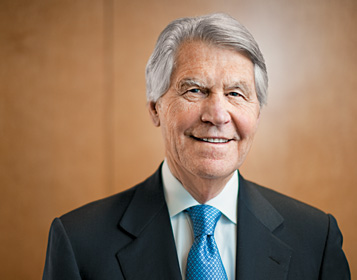
For the past three decades, I have shared my thoughts about the company’s progress and the impact of the year’s most significant events in a letter like this. Now, after becoming Stryker’s chairman emeritus on January 1, 2010, I am pleased to have the opportunity to write a final letter to you, my fellow shareholders.
As the first step in a multiyear transition plan, Steve MacMillan joined Stryker’s leadership team as president and COO in 2003. At the beginning of 2005, Steve took on the CEO title and the responsibilities for the company’s day-to-day operations. Now, as planned, the final step of the process has been completed and Steve has been named chairman, president and CEO.
This transition was yet another step in the continuing evolution of the company. Like other successful companies, Stryker has experienced numerous changes throughout our history. In the late 1930’s and early 1940’s, Homer Stryker, an orthopaedic surgeon in Kalamazoo, Michigan, began inventing medical devices to enhance his practice and produce better outcomes for his patients. Other medical professionals took notice and soon he began making these devices for them.
In the mid-1950’s, when Dr. Stryker’s son, Lee, joined the family business, he saw the opportunity to expand the company, first in the U.S., and eventually in international markets, by focusing on sales and marketing activities. Under Lee’s leadership, sales grew to be 17 times larger than when he first joined the company.
Then in the 1970’s, Stryker became a publicly traded company and set the goal of growing earnings per share by at least 20% each year. That goal united us and challenged everyone in the company to continually perform at an exceptional level. Strategic acquisitions brought diversification into joint replacements, trauma and spinal implants, as well as operating room, endoscopy and hospital equipment. Investments in research and development strengthened and expanded each product line, helping us enter other new businesses.
During this same period, remarkable progress was occurring in the orthopaedic market, as well as the entire medical technology industry. For example, 30 years ago the majority of today’s hip and knee replacements were merely concepts. Today, they have become widely accepted as the way to restore mobility and reduce or eliminate joint pain. And today’s highly advanced equipment allows surgeons to perform complicated, life-enhancing and life-saving procedures that would have been impossible just a few years ago.
Improvements in the quality, safety and efficacy of both products and procedures have enhanced patient care and have brought cost savings and efficiency to the world’s healthcare systems. These advances have occurred as political parties have come into power and fallen out of favor. New ideas and policies have been rigorously debated, enacted and then modified or replaced as circumstances and sentiments have changed. Those companies that adapted to these changes were the ones that grew and prospered.
Today, Stryker is one of the largest, most broadly based medical technology companies in the world. We have continually evolved by setting challenging goals, working hard to achieve those goals and by having an unwavering commitment to abide by the rules.
As another chapter in Stryker’s history begins, there will undoubtedly be challenges brought about by stricter regulations, price and reimbursement pressures, new taxes and healthcare reforms. Yet I have confidence that the company will respond as it always has and meet each new challenge. Stryker Corporation will become larger, stronger and better as it continues to positively impact millions of people every day.
Thank you for the confidence that you have demonstrated by investing in the company. May the legacy continue!
Sincerely,
John W. Brown
Chairman Emeritus


